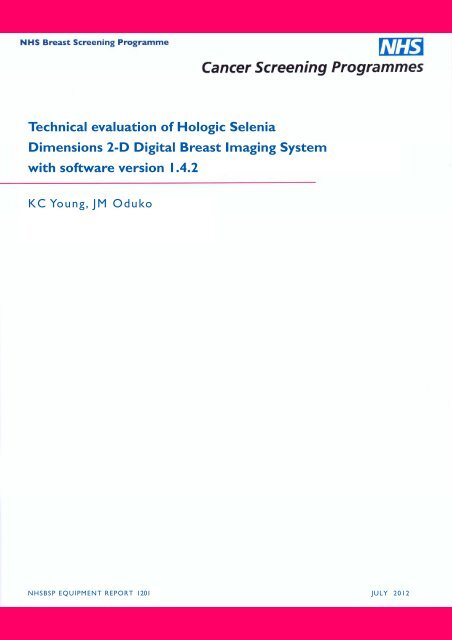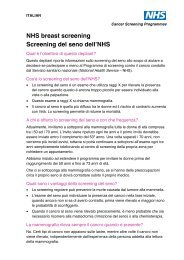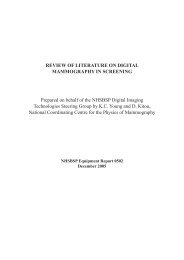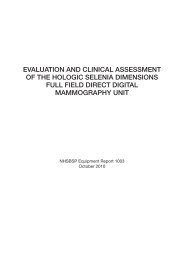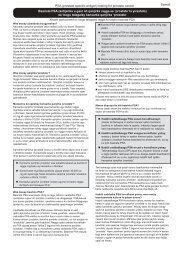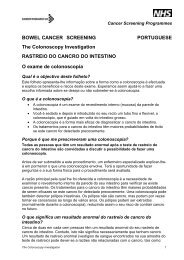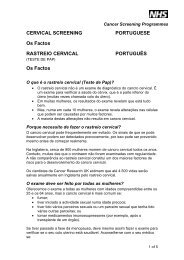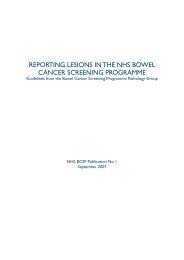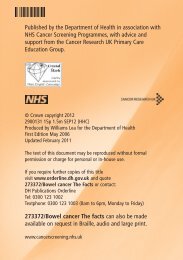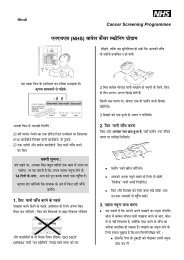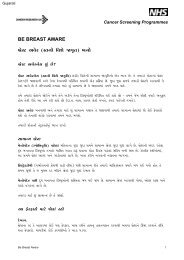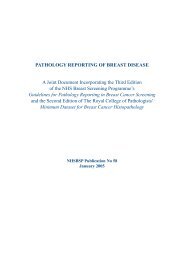NHSBSP EQUIP 1201 Tech eval of Hologic Selenia Dimensions 2-D ...
NHSBSP EQUIP 1201 Tech eval of Hologic Selenia Dimensions 2-D ...
NHSBSP EQUIP 1201 Tech eval of Hologic Selenia Dimensions 2-D ...
You also want an ePaper? Increase the reach of your titles
YUMPU automatically turns print PDFs into web optimized ePapers that Google loves.
<strong>Tech</strong>nical <strong>eval</strong>uation <strong>of</strong> <strong>Hologic</strong> <strong>Selenia</strong><br />
<strong>Dimensions</strong> 2-D Digital Breast Imaging System<br />
with s<strong>of</strong>tware version 1.4.2<br />
KC Young, JM Oduko<br />
<strong>NHSBSP</strong> <strong>EQUIP</strong>MENT REPORT <strong>1201</strong><br />
JULY 2012
<strong>Tech</strong>nical <strong>eval</strong>uation <strong>of</strong> <strong>Hologic</strong> <strong>Selenia</strong><br />
<strong>Dimensions</strong> 2-D Digital Breast Imaging<br />
System with s<strong>of</strong>tware version 1.4.2<br />
<strong>NHSBSP</strong> <strong>EQUIP</strong>MENT REPORT <strong>1201</strong><br />
July 2012
Authors<br />
JM Oduko<br />
KC Young<br />
National Coordinating Centre for the Physics <strong>of</strong> Mammography, Guilford<br />
Editor<br />
Kiera Chapman<br />
NHS Cancer Screening Programmes<br />
Typesetting and Design<br />
Mary Greatorex<br />
NHS Cancer Screening Programmes<br />
Published by<br />
NHS Cancer Screening Programmes<br />
Fulwood House<br />
Old Fulwood Road<br />
Sheffield<br />
S10 3TH<br />
Tel: 0114 271 1060<br />
Fax: 0114 271 1089<br />
Email: info@cancerscreening.nhs.uk<br />
Website: www.cancerscreening.nhs.uk<br />
© NHS Cancer Screening Programmes 2012<br />
The contents <strong>of</strong> this document may be copied for use by staff working in the public sector<br />
but may not be copied for any other purpose without prior permission from the NHS<br />
Cancer Screening Programmes.<br />
The report is available in PDF format on the NHS Cancer Screening Programmes‟<br />
website.
Version Control<br />
<strong>Tech</strong>nical <strong>eval</strong>uation <strong>of</strong> <strong>Hologic</strong> <strong>Selenia</strong> <strong>Dimensions</strong><br />
2-D Digital Breast Imaging System with s<strong>of</strong>tware<br />
version 1.4.2<br />
Electronic publication date<br />
Review date (1)<br />
Review date (2)<br />
Comments<br />
Version<br />
Description <strong>of</strong><br />
change<br />
July 2012<br />
July 2013<br />
May be sent to Pr<strong>of</strong>essor Ken Young,<br />
ken.young@nhs.net in readiness for review.<br />
Interim Amendments<br />
Author Date
<strong>Tech</strong>nical Evaluation <strong>of</strong> <strong>Hologic</strong> <strong>Selenia</strong> <strong>Dimensions</strong> 2-D with s<strong>of</strong>tware version 1.4.2 iii<br />
_______________________________________________________________________<br />
CONTENTS<br />
ACKNOWLEDGEMENTS iv<br />
1. INTRODUCTION 1<br />
1.1 Testing procedures and performance standards for digital mammography 1<br />
1.2 Objectives 1<br />
2. METHODS 2<br />
2.1 System tested 2<br />
2.2 Output and half-value-layer (HVL) 3<br />
2.3 Detector response 3<br />
2.4 Dose measurement 3<br />
2.5 Contrast-to-noise ratio (CNR) 4<br />
2.6 AEC performance for local dense areas 5<br />
2.7 Noise analysis 6<br />
2.8 Image quality measurements 7<br />
2.9 Image retention 8<br />
2.10 Physical measurements <strong>of</strong> the detector performance 8<br />
2.11 Optimisation 8<br />
3. RESULTS 9<br />
3.1 Output and HVL 9<br />
3.2 Detector response 9<br />
3.3 AEC performance 10<br />
3.4 Noise measurements 13<br />
3.5 Image quality measurements 1<br />
3.6 Comparison with other systems 4<br />
3.7 Artefact 8<br />
4. DISCUSSION 9<br />
5. CONCLUSIONS 9<br />
6. REFERENCES 10<br />
____________________________________________________________________<br />
<strong>NHSBSP</strong> July 2012
<strong>Tech</strong>nical Evaluation <strong>of</strong> <strong>Hologic</strong> <strong>Selenia</strong> <strong>Dimensions</strong> 2-D with s<strong>of</strong>tware version 1.4.2 iv<br />
_______________________________________________________________________<br />
ACKNOWLEDGEMENTS<br />
The authors are grateful to the staff at the Jarvis Breast Screening Centre, Guildford for<br />
their cooperation in <strong>eval</strong>uating the equipment at their site.<br />
____________________________________________________________________<br />
<strong>NHSBSP</strong> July 2012
<strong>Tech</strong>nical Evaluation <strong>of</strong> <strong>Hologic</strong> <strong>Selenia</strong> <strong>Dimensions</strong> 2-D with s<strong>of</strong>tware version 1.4.2 1<br />
_______________________________________________________________________<br />
1. INTRODUCTION<br />
1.1 Testing procedures and performance standards for digital mammography<br />
This report is one <strong>of</strong> a series <strong>eval</strong>uating commercially available digital mammography<br />
systems on behalf <strong>of</strong> the NHS Breast Screening Programme (<strong>NHSBSP</strong>). The testing<br />
methods and standards applied are mainly derived from <strong>NHSBSP</strong> Equipment Report<br />
0604, and are referred to in this document as „the <strong>NHSBSP</strong> protocol. 1 The standards for<br />
image quality and dose within the <strong>NHSBSP</strong> protocol are the same as those <strong>of</strong> the<br />
European protocol, but the latter has been followed where it provides a more detailed<br />
performance standard: for example, for the automatic exposure control (AEC) system. 2,3<br />
1.2 Objectives<br />
The purpose <strong>of</strong> these tests was to produce an update to <strong>NHSBSP</strong> report 1101 4 on the<br />
<strong>Dimensions</strong> Breast Imaging System, and to <strong>eval</strong>uate a s<strong>of</strong>tware upgrade, Version 1.4.2,<br />
prior to its potential rollout in the <strong>NHSBSP</strong> in England. Two specific areas <strong>of</strong> the upgrade<br />
were considered:<br />
(1) The new AEC table, designed to maintain a more constant contrast-to-noise ratio<br />
(CNR) at all breast thicknesses, resulting in an increase dose in cases where breast<br />
thickness is ≥ 5cm.<br />
(2) The new s<strong>of</strong>tware‟s ability to remove the artefacts that were associated with image<br />
processing in previous versions, e.g. dark areas around high contrast objects such as<br />
„MRI coils‟.<br />
The tomographic performance <strong>of</strong> the system was not <strong>eval</strong>uated. Clinical <strong>eval</strong>uations are<br />
published separately by the <strong>NHSBSP</strong> where systems meet the minimum standards<br />
outlined in the <strong>NHSBSP</strong> protocol. A final decision on the suitability <strong>of</strong> systems for use<br />
within the <strong>NHSBSP</strong> depends on a review <strong>of</strong> both the technical and clinical <strong>eval</strong>uations.<br />
____________________________________________________________________<br />
<strong>NHSBSP</strong> July 2012
<strong>Tech</strong>nical Evaluation <strong>of</strong> <strong>Hologic</strong> <strong>Selenia</strong> <strong>Dimensions</strong> 2-D with s<strong>of</strong>tware version 1.4.2 2<br />
_______________________________________________________________________<br />
2. METHODS<br />
2.1 System tested<br />
The tests were conducted at the Jarvis Breast Screening Centre in Guildford, on a<br />
<strong>Dimensions</strong> system installed in 2011 and described in Table 1. The system had been<br />
upgraded and the AEC curve had been adjusted to be as close as possible to the <strong>Hologic</strong><br />
specifications.<br />
Table 1, below, updates the data from the previously published report on the <strong>Hologic</strong><br />
<strong>Selenia</strong> <strong>Dimensions</strong> 4 and contains some corrected values for added filtration and detector<br />
area.<br />
Table 1 System Description<br />
Manufacturer <strong>Hologic</strong> Inc<br />
Model <strong>Dimensions</strong><br />
System serial number 81011100510<br />
X-ray tube Varian M-113T<br />
Target material Tungsten<br />
Added filtration 50 µm Rhodium<br />
50 µm Silver<br />
Detector type Amorphous selenium<br />
Detector serial number MM601656<br />
Pixel size 70 µm (in detector plane)<br />
Detector area Small: 179 x 233 mm<br />
Large: 233 x 287 mm<br />
Pixel array Small: 2560 x 3328<br />
Large: 3328 x 4096<br />
Pixel value <strong>of</strong>fset 50<br />
Source to detector distance 700 mm<br />
Source to table distance 675 mm<br />
AEC modes* AutoFilter, AutokV, AutoTime<br />
AEC pre-exposure pulse 5 mAs for CBT < 5 cm; 10 mAs for CBT ≥ 5 cm<br />
S<strong>of</strong>tware version(s) AWS:1.4.2.246\M35:1.2.2.34\GIP2D:3.11.0-<br />
4.11.2\GIP3D:1.1.0.2\SNRCNR:1.0.0.0-<br />
1.0.1.0\PMC:1.4.2.2\DET:1.4.1.5\DTC:1.0.0.9\<br />
GCB:1.4.2.4GEN:1.4.2.0\VTA:1.4.0.15\CRM:1.4.2.0\<br />
THD:1.4.0.7\CDI:1.4.0.9\AIO:1.4.0.0\BKY:1.4.0.3<br />
____________________________________________________________________<br />
<strong>NHSBSP</strong> July 2012
<strong>Tech</strong>nical Evaluation <strong>of</strong> <strong>Hologic</strong> <strong>Selenia</strong> <strong>Dimensions</strong> 2-D with s<strong>of</strong>tware version 1.4.2 3<br />
_______________________________________________________________________<br />
The AEC modes are as follows:<br />
AutoFilter: System selects kV, filter, and mAs. (Choice <strong>of</strong> kV and filter is based on<br />
compressed breast thickness).<br />
AutokV: User selects filter, system selects kV and mAs.<br />
AutoTime: User selects filter and kV, system selects mAs.<br />
Position 2 was selected for all AEC measurements except the local dense area test, for<br />
which Auto was used.<br />
In all cases, the pre-exposure pulse contributes to patient dose but does not contribute to<br />
the formation <strong>of</strong> the image. The pre-pulse is 5 mAs where compressed breast thickness is<br />
< 5 cm, and 10 mAs where breast thickness is > 5 cm.<br />
2.2 Output and half-value-layer (HVL)<br />
The output and HVL were measured in the manner described in the <strong>NHSBSP</strong> protocol, at<br />
intervals <strong>of</strong> 3 kV for each target/filter combination.<br />
2.3 Detector response<br />
The detector response was measured in the manner described in the <strong>NHSBSP</strong> protocol,<br />
with a 45 mm thickness <strong>of</strong> Perspex (polymethylmethacrylate, or PMMA) placed at the<br />
tube exit port. An ion chamber was positioned above the table, 4 cm in from the chest<br />
wall edge, to determine the incident air kerma at the detector surface for a range <strong>of</strong><br />
manually set mAs values at 29 kV, and for both available target/filter combinations (W/Rh<br />
and W/Ag). The readings were corrected to the surface <strong>of</strong> the detector using the inverse<br />
square law. No correction was made for attenuation by the table and detector cover.<br />
Images were saved as unprocessed files and transferred to another computer for<br />
analysis. A 10 mm square region <strong>of</strong> interest (ROI) was positioned on the midline, 4 cm<br />
from the chest wall edge <strong>of</strong> each image. The average pixel value and the standard<br />
deviation <strong>of</strong> pixel values within that region were measured. The relationship between<br />
average pixel values and the detector entrance surface air kerma was determined.<br />
2.4 Dose measurement<br />
Doses were measured using the x-ray set‟s automatic exposure control (AEC) to expose<br />
different thicknesses <strong>of</strong> PMMA. Each thickness had an area <strong>of</strong> 18 x 24 cm. The paddle<br />
height was adjusted to be equal to the equivalent breast thickness. Mean glandular doses<br />
(MGDs) were calculated for the equivalent breast thicknesses. To measure the contrastto-noise<br />
ratio (CNR), an aluminium square measuring 10 mm x 10 mm in area and 0.2<br />
mm in depth was placed on top <strong>of</strong> a 20 mm thick block, with one edge on the midline, 6<br />
cm from the chest wall edge. Additional layers <strong>of</strong> PMMA were placed on top <strong>of</strong> these to<br />
vary the total thickness.<br />
____________________________________________________________________<br />
<strong>NHSBSP</strong> July 2012
<strong>Tech</strong>nical Evaluation <strong>of</strong> <strong>Hologic</strong> <strong>Selenia</strong> <strong>Dimensions</strong> 2-D with s<strong>of</strong>tware version 1.4.2 4<br />
_______________________________________________________________________<br />
2.5 Contrast-to-noise ratio (CNR)<br />
The images <strong>of</strong> the PMMA blocks obtained during the dose measurement were analysed<br />
to obtain the CNRs. Twenty small square ROIs (approximately 2.5 mm x 2.5 mm) were<br />
used to determine both the average signal and the standard deviations in the signal within<br />
the image <strong>of</strong> the aluminium square (4 ROI) and its surrounding background (16 ROI), as<br />
shown in Figure 1. Small ROIs are used to minimise distortions resulting from the heel<br />
effect and other causes <strong>of</strong> non-uniformity. 5 This is less important for DR systems than for<br />
computed radiography systems, however, because a flat-field correction is applied. The<br />
CNR was calculated for each image, as defined in the <strong>NHSBSP</strong> and European protocols.<br />
Figure 1 Location and size <strong>of</strong> ROI used to determine the CNR.<br />
To apply the standards in the European protocol, the limiting value for CNR (using 50 mm<br />
PMMA) was determined according to Equation 1, below. This equation determines the<br />
CNR value (CNRlimiting value) that is necessary to achieve the minimum threshold gold<br />
thickness for the 0.1 mm detail (i.e. threshold goldlimiting value = 1.68 μm which is equivalent<br />
to threshold contrastlimiting value = 23.0%, using 28 kV Mo/Mo). Threshold contrasts were<br />
calculated in the manner described in the European protocol and in Equation 1.<br />
CNRlimiting value =<br />
TC<br />
CNR (1)<br />
measured<br />
measured<br />
TClimitingvalue<br />
The relative CNR was then calculated according to Equation 2, and compared with the<br />
limiting values provided for relative CNR shown in Table 2. The minimum CNR required<br />
to meet this criterion was then calculated.<br />
Relative CNR = CNRmeasured /CNRlimiting value<br />
____________________________________________________________________<br />
<strong>NHSBSP</strong> July 2012<br />
(2)
<strong>Tech</strong>nical Evaluation <strong>of</strong> <strong>Hologic</strong> <strong>Selenia</strong> <strong>Dimensions</strong> 2-D with s<strong>of</strong>tware version 1.4.2 5<br />
_______________________________________________________________________<br />
Table 2 Limiting values for relative CNR<br />
Thickness <strong>of</strong><br />
PMMA (mm)<br />
Equivalent breast<br />
thickness (mm)<br />
20 21 >115<br />
30 32 >110<br />
40 45 >105<br />
45 53 >103<br />
50 60 >100<br />
60 75 >95<br />
70 90 >90<br />
2.6 AEC performance for local dense areas<br />
Limiting values for relative<br />
CNR (%) in European<br />
protocol<br />
The method used in the EUREF type testing protocol was followed. To simulate local<br />
dense areas, nine images were made, and areas <strong>of</strong> extra attenuation <strong>of</strong> different<br />
thicknesses (2–18 mm) were added. The compression plate remained in position at a 40<br />
mm height, as shown in Figure 2.<br />
Figure 2 Setup to measure AEC performance for local dense areas<br />
In the area <strong>of</strong> extra attenuation (20 x 40 mm PMMA), the mean pixel value and standard<br />
deviation were measured for a ROI with dimensions 2.5 x 2.5 mm, and the signal-to-noise<br />
ratio (SNR) calculated.<br />
____________________________________________________________________<br />
<strong>NHSBSP</strong> July 2012
<strong>Tech</strong>nical Evaluation <strong>of</strong> <strong>Hologic</strong> <strong>Selenia</strong> <strong>Dimensions</strong> 2-D with s<strong>of</strong>tware version 1.4.2 6<br />
_______________________________________________________________________<br />
2.7 Noise analysis<br />
The images acquired while measuring detector response using 29 kV W/Rh were used to<br />
analyse the image noise. A ROI, comprising an area <strong>of</strong> 5 x 5 mm was placed on the<br />
midline, 6 cm from the chest wall edge. This ROI was divided into four smaller ROI<br />
measuring 2.5 mm x 2.5 mm and the average standard deviations <strong>of</strong> the pixel values in<br />
these for each image were used to investigate the relationship between dose, detector,<br />
and image noise. It was assumed that this noise comprises three components –<br />
electronic noise, structural noise, and quantum noise – with the relationship shown in<br />
Equation 3:<br />
2 2 2 2<br />
p ke kq<br />
p ks<br />
p<br />
(3)<br />
where p is the standard deviation in pixel values within an ROI with a uniform exposure<br />
and a mean pixel value, p, and ke, kq, and ks are the coefficients determining the amount<br />
<strong>of</strong> electronic, quantum, and structural noise in a pixel with a value, p.<br />
This method <strong>of</strong> analysis has been described previously. 5 For simplicity the noise is<br />
generally presented here as relative noise, defined in equation 4.<br />
p<br />
Relative noise = (4)<br />
p<br />
The variation in relative noise with mean pixel value was <strong>eval</strong>uated and fitted using<br />
Equation 3, and non-linear regression was used to determine the best fit for the constants<br />
and their asymptotic confidence limits (using GraphPad Prism Version 5 for Windows * ).<br />
This established whether the experimental measurements <strong>of</strong> the noise fitted this<br />
equation, and the relative proportions <strong>of</strong> the different noise components. In fact, the<br />
relationship between noise and pixel values has been empirically found to be<br />
approximated by a simple power relationship, as shown in Equation 5.<br />
<br />
p<br />
p<br />
k<br />
t<br />
p<br />
n<br />
Here, kt is a constant. If the noise were purely quantum noise the value <strong>of</strong> n would be 0.5.<br />
However the presence <strong>of</strong> electronic and structural noise means that n can be slightly<br />
higher or lower than 0.5.<br />
The variance in pixel values within a ROI is defined as the standard deviation squared.<br />
The total variance was plotted against incident air kerma at the detector and fitted using<br />
Equation 3. Again, non-linear regression was used to determine the best fit for the<br />
constants and their asymptotic confidence limits, using the GraphPad Prism s<strong>of</strong>tware.<br />
* GraphPad S<strong>of</strong>tware, Inc, San Diego, California, USA, www.graphpad.com.<br />
____________________________________________________________________<br />
<strong>NHSBSP</strong> July 2012<br />
(5)
<strong>Tech</strong>nical Evaluation <strong>of</strong> <strong>Hologic</strong> <strong>Selenia</strong> <strong>Dimensions</strong> 2-D with s<strong>of</strong>tware version 1.4.2 7<br />
_______________________________________________________________________<br />
Using the calculated constants, the structural, electronic, and quantum components <strong>of</strong> the<br />
variance were estimated, assuming that each component was independently related to<br />
incident air kerma. The percentage <strong>of</strong> the total variance represented by each component<br />
was then calculated and plotted against incident air kerma at the detector. From this, the<br />
dose range over which the quantum component dominates was estimated.<br />
2.8 Image quality measurements<br />
Contrast detail measurements were made using a CDMAM phantom † , serial number<br />
1022. The phantom was positioned with a 20 mm thickness <strong>of</strong> PMMA above and below, to<br />
give a total attenuation approximately equivalent to 50 mm <strong>of</strong> PMMA, or 60 mm <strong>of</strong> typical<br />
breast tissue. The kV target/filter combination and mAs were chosen to match as closely<br />
as possible to those selected by the AEC when imaging a 5 cm thickness <strong>of</strong> PMMA. This<br />
procedure was repeated to obtain a representative sample <strong>of</strong> 16 images at this dose level.<br />
Unprocessed images were transferred to disk for subsequent analysis <strong>of</strong>f-site. Further<br />
images <strong>of</strong> the test phantom were then obtained at other dose levels by manually selecting<br />
higher and lower mAs values with the same beam quality. An automatic method <strong>of</strong><br />
reading the CDMAM images was used. 6,7 The threshold gold thickness for a typical<br />
human observer was predicted using Equation 6.<br />
TCpredicted = r TCauto<br />
TCpredicted is the predicted threshold contrast for a typical observer, and TCauto is the<br />
threshold contrast measured using an automated procedure with CDMAM images.<br />
Contrasts were calculated from gold thickness for a nominal tube voltage <strong>of</strong> 28 kV and a<br />
Mo/Mo target/filter combination (as described in the European protocol); r is the average<br />
ratio between human and automatic threshold contrast, determined experimentally with<br />
the values shown in Table 3. 7<br />
Table 3 Values <strong>of</strong> r used to predict threshold contrast<br />
Diameter <strong>of</strong> gold disc (mm)<br />
0.08 1.40<br />
0.10 1.50<br />
0.13 1.60<br />
0.16 1.68<br />
0.20 1.75<br />
0.25 1.82<br />
0.31 1.88<br />
0.40 1.94<br />
0.50 1.98<br />
0.63 2.01<br />
0.80 2.06<br />
1.00 2.11<br />
† Version 3.4, UMC St. Radboud, Nijmegen University, Netherlands<br />
Average ratio <strong>of</strong> human to automatically<br />
measured threshold contrast (r)<br />
____________________________________________________________________<br />
<strong>NHSBSP</strong> July 2012<br />
(6)
<strong>Tech</strong>nical Evaluation <strong>of</strong> <strong>Hologic</strong> <strong>Selenia</strong> <strong>Dimensions</strong> 2-D with s<strong>of</strong>tware version 1.4.2 8<br />
_______________________________________________________________________<br />
The main advantage <strong>of</strong> automatic reading is that it has the potential to eliminate observer<br />
error, which is a significant problem when using human readers. However, it should be<br />
noted that at the present time, the <strong>of</strong>ficial protocols are based on human reading.<br />
The predicted threshold gold thickness for each detail diameter at each dose level was<br />
fitted with a curve, as described in the <strong>NHSBSP</strong> protocol. The confidence limits for the<br />
predicted threshold gold thicknesses had been previously determined via a resampling<br />
method, using a large set <strong>of</strong> images. The threshold contrasts quoted in the tables <strong>of</strong><br />
results are derived from the fitted curves, as this has been found to improve accuracy. 6<br />
The expected relationship between threshold contrast and dose is shown in Equation 7.<br />
Threshold contrast = λ D -n (7)<br />
D represents the MGD for a 60 mm thick standard breast, equivalent to the test phantom<br />
configuration used for the image quality measurement, and λ is a constant to be fitted. It is<br />
assumed that a similar equation applies when using threshold gold thickness, rather than<br />
contrast. This equation was plotted with the experimental data for each detail size from<br />
0.1 to 1.0 mm. The value <strong>of</strong> n resulting in the best fit to the experimental data was<br />
determined.<br />
2.9 Image retention<br />
Not measured.<br />
2.10 Physical measurements <strong>of</strong> the detector performance<br />
Not measured.<br />
2.11 Optimisation<br />
Not performed.<br />
2.12 Artefact <strong>eval</strong>uation<br />
A small metal coil on a breast-like phantom was imaged, to verify that there no dark region<br />
was visible on the image around the coil (which would obscure calcifications, for<br />
example). Such dark areas had been observed on processed images with the previous<br />
s<strong>of</strong>tware version. A line was drawn through the coil and surrounding area, and a pr<strong>of</strong>ile<br />
was plotted. The image and pr<strong>of</strong>ile were compared with those acquired prior to the<br />
upgrade.<br />
____________________________________________________________________<br />
<strong>NHSBSP</strong> July 2012
<strong>Tech</strong>nical Evaluation <strong>of</strong> <strong>Hologic</strong> <strong>Selenia</strong> <strong>Dimensions</strong> 2-D with s<strong>of</strong>tware version 1.4.2 9<br />
_______________________________________________________________________<br />
3. RESULTS<br />
3.1 Output and HVL<br />
The results are shown in Table 4.<br />
Table 4 Output and HVL<br />
Output<br />
(mGy/mAs<br />
at 1m)<br />
Output<br />
(mGy/mAs<br />
at 1m)<br />
kV T/F<br />
HVL<br />
(mm Al) kV T/F<br />
25 W/Rh 11.2 0.48 25 W/Ag 12.6 0.49<br />
28 W/Rh 15.7 0.51 28 W/Ag 18.4 0.54<br />
HVL<br />
(mm Al)<br />
31 W/Rh 20.1 0.54 31 W/Ag 24.2 0.58<br />
34 W/Rh 24.4 0.56 34 W/Ag 29.8 0.61<br />
37 W/Rh 28.6 0.59 37 W/Ag 35.4 0.64<br />
3.2 Detector response<br />
The detector was found to have a linear response, with an <strong>of</strong>fset <strong>of</strong> 50, as shown in Figure<br />
3.<br />
Mean pixel value<br />
3000<br />
2000<br />
1000<br />
0<br />
29kV W/Rh<br />
29kV W/Ag<br />
y = 2.9639x + 50<br />
R 2 = 1<br />
y = 2.4327x + 50<br />
R 2 = 1<br />
0 200 400 600 800 1000<br />
Figure 3 Detector response.<br />
Incident air kerma at surface <strong>of</strong> detector (uGy)<br />
____________________________________________________________________<br />
<strong>NHSBSP</strong> July 2012
<strong>Tech</strong>nical Evaluation <strong>of</strong> <strong>Hologic</strong> <strong>Selenia</strong> <strong>Dimensions</strong> 2-D with s<strong>of</strong>tware version 1.4.2 10<br />
_______________________________________________________________________<br />
3.3 AEC performance<br />
3.3.1 Dose<br />
The mean glandular doses for breasts simulated with PMMA and exposed under AEC<br />
control are shown in Table 5 and Figure 4. At all thicknesses, the dose was below the<br />
remedial level given in the <strong>NHSBSP</strong> protocol, which is the same as the maximum<br />
acceptable level in the European Protocol. The „displayed MGD‟ values in Table 5 are<br />
calculated according to Wu et al. 8 , and are not expected to be identical to the MGD values<br />
presented in column 8 <strong>of</strong> Table 5, which are calculated according to Dance et al. 9 (Values<br />
calculated according to Wu et al. are expected to be about 10% lower than those<br />
calculated according to Dance et al.)<br />
The main effect <strong>of</strong> the AEC s<strong>of</strong>tware upgrade was to increase the MGDs (and CNRs) for<br />
larger breasts. The MGD for 53 mm PMMA thickness (1.36 mGy) was found to be slightly<br />
lower than the target value <strong>of</strong> 1.42 mGy supplied by <strong>Hologic</strong>, but was within tolerance<br />
limits.<br />
The pre-exposure pulse used in AEC modes is 5 mAs for compressed breast thicknesses<br />
<strong>of</strong> less than 50 mm, and 10 mAs for thicknesses equal to or greater than 50 mm. This<br />
contributes to the mean glandular dose, but is not used to produce the digital image.<br />
Table 5 Mean glandular dose for simulated breasts (AutoFilter mode)<br />
Equivalent<br />
MGD MGD % <strong>NHSBSP</strong><br />
PMMA breast<br />
before after Increase remedial Displayed<br />
thickness thickness<br />
upgrade upgrade in level MGD<br />
(mm) (mm) kV Target Filter mAs* (mGy) (mGy) MGD (mGy) (mGy)<br />
20 21 25 W Rh 45 0.57 0.55 4 >1.0 0.56<br />
30 32 26 W Rh 69 0.80 0.79 1 >1.5 0.78<br />
40 45 28 W Rh 90 1.09 1.19 -8 >2.0 1.05<br />
45 53 29 W Rh 108 1.36 1.40 -3 >2.5 1.27<br />
50 60 31 W Rh 131 1.87 1.65 13 >3.0 1.72<br />
60 75 31 W Ag 156 2.51 1.85 36 >4.5 2.29<br />
70 90 34 W Ag 154 2.89 2.26 28 >6.5 2.65<br />
*mAs values here include pre-exposure mAs, as this contributes to the MGD.<br />
____________________________________________________________________<br />
<strong>NHSBSP</strong> July 2012
<strong>Tech</strong>nical Evaluation <strong>of</strong> <strong>Hologic</strong> <strong>Selenia</strong> <strong>Dimensions</strong> 2-D with s<strong>of</strong>tware version 1.4.2 11<br />
_______________________________________________________________________<br />
MGD (mGy)<br />
8<br />
6<br />
4<br />
2<br />
0<br />
Remedial Level<br />
Measured MGD after upgrade<br />
Displayed MGD after upgrade<br />
Measured MGD before upgrade<br />
20 40 60 80 100<br />
Equivalent breast thickness (mm)<br />
Figure 4 MGD for different thicknesses <strong>of</strong> simulated breasts using the AutoFilter mode.<br />
3.3.2 CNR<br />
The results <strong>of</strong> the contrast and CNR measurements are shown in Table 6 and Figure 5.<br />
The CNRs that are required to meet the minimum acceptable and achievable image<br />
quality standards at the 60 mm breast thickness are shown, along with the CNR required<br />
at each thickness to meet the limiting values for CNR in the European protocol.<br />
____________________________________________________________________<br />
<strong>NHSBSP</strong> July 2012
<strong>Tech</strong>nical Evaluation <strong>of</strong> <strong>Hologic</strong> <strong>Selenia</strong> <strong>Dimensions</strong> 2-D with s<strong>of</strong>tware version 1.4.2 12<br />
_______________________________________________________________________<br />
Table 6 Contrast and CNR measurements using AEC<br />
% contrast for 0.2 mm Al<br />
CNR to meet European<br />
limiting value<br />
21 25 W/Rh 45 321 20.10% 10.55 3.85 5.69 4.43 >115<br />
32 26 W/Rh 69 321 18.90% 9.52 3.85 5.69 4.24 >110<br />
45 28 W/Rh 90 321 16.90% 8.39 3.85 5.69 4.05 >105<br />
53 29 W/Rh 108 332 16.10% 8.13 3.85 5.69 3.97 >103<br />
60 31 W/Rh 131 419 14.20% 8.13 3.85 5.69 3.86 >100<br />
75 31 W/Ag 156 553 12.00% 7.74 3.85 5.69 3.66 >95<br />
90 34 W/Ag 154 569 9.90% 6.42 3.85 5.69 3.47 >90<br />
*mAs values here do not include pre-exposure mAs, as this does not contribute to the<br />
image.<br />
CNR for 0.2 mmAl<br />
Equivalent breast thickness<br />
(mm)<br />
15<br />
10<br />
5<br />
kV target/ filter<br />
mAs*<br />
Back-ground pixel value<br />
____________________________________________________________________<br />
Measured CNR<br />
CNR at minimum acceptable<br />
IQ<br />
CNR at minimum IQ<br />
CNR at achievable IQ<br />
CNR to meet European limiting value<br />
Measured CNR<br />
CNR at achievable lQ<br />
0<br />
10 20 30 40<br />
PMMA thickness (mm)<br />
50 60 70<br />
Figure 5 Measured CNR compared with the limiting values in the European protocol for<br />
the system. (Error bars indicate 95% confidence limits.)<br />
<strong>NHSBSP</strong> July 2012<br />
European limiting values for<br />
relative CNR
<strong>Tech</strong>nical Evaluation <strong>of</strong> <strong>Hologic</strong> <strong>Selenia</strong> <strong>Dimensions</strong> 2-D with s<strong>of</strong>tware version 1.4.2 13<br />
_______________________________________________________________________<br />
3.3.3 AEC performance for local dense areas<br />
It is expected that when the AEC adjusts for locally dense areas, the SNR will remain<br />
constant in that area as extra PMMA layers are added, as shown in Table 7 and Figure 6.<br />
Table 7 AEC performance for local dense areas (AutoFilter mode)<br />
Attenuation Target/ Tube voltage Tube load SNR<br />
(mm PMMA) filter (kV) (mAs)<br />
32 W/Rh 28 51 53.1<br />
34 W/Rh 28 65 56.8<br />
36 W/Rh 28 73 56.1<br />
38 W/Rh 28 82 56.9<br />
40 W/Rh 28 93 58.5<br />
42 W/Rh 28 104 58.1<br />
44 W/Rh 28 115 55.7<br />
46 W/Rh 28 131 58.6<br />
48 W/Rh 28 144 57.4<br />
SNR<br />
80<br />
60<br />
40<br />
20<br />
0<br />
30 35 40 45 50 55<br />
PMMA thickness (mm)<br />
Figure 6 AEC performance for local dense areas.<br />
3.4 Noise measurements<br />
The variation in noise with dose was analysed by plotting the standard deviation in pixel<br />
values against the detector entrance air kerma, as shown in Figure 7. The fitted power<br />
curve has an index <strong>of</strong> 0.44. If quantum noise sources alone were present, the data would<br />
form a straight line with an index <strong>of</strong> 0.5. The data deviates from a straight line at lower<br />
doses owing to the presence <strong>of</strong> electronic noise. This is normal for such systems.<br />
Quantum noise was the dominant noise source.<br />
____________________________________________________________________<br />
<strong>NHSBSP</strong> July 2012
<strong>Tech</strong>nical Evaluation <strong>of</strong> <strong>Hologic</strong> <strong>Selenia</strong> <strong>Dimensions</strong> 2-D with s<strong>of</strong>tware version 1.4.2 14<br />
_______________________________________________________________________<br />
Standard deviation in background<br />
100<br />
10<br />
y = 0.696x 0.441<br />
SD <strong>of</strong> background<br />
Fit to data<br />
1<br />
1 10 100 1000<br />
Incident air kerma at surface <strong>of</strong> detector (µGy)<br />
Figure 7 Standard deviation <strong>of</strong> pixel values versus air kerma at detector.<br />
Figure 8 is an alternative way <strong>of</strong> presenting the data and shows the relative noise at<br />
different entrance air kerma. The estimated relative contributions <strong>of</strong> electronic, structural,<br />
and quantum noise are shown and the quadratic sum <strong>of</strong> these contributions fitted to the<br />
measured noise (using Equation 3). Figure 9 shows the different amounts <strong>of</strong> variance<br />
caused by each component. Quantum noise predominates over the clinical range.<br />
Relative noise<br />
0.15<br />
0.10<br />
0.05<br />
0.00<br />
0 200 400 600<br />
Incident air kerma at detector (Gy)<br />
Measured noise<br />
Electronic noise<br />
Structured noise<br />
Quantum noise<br />
Figure 8 Relative noise and noise components at different pixel values.<br />
____________________________________________________________________<br />
<strong>NHSBSP</strong> July 2012
<strong>Tech</strong>nical Evaluation <strong>of</strong> <strong>Hologic</strong> <strong>Selenia</strong> <strong>Dimensions</strong> 2-D with s<strong>of</strong>tware version 1.4.2 1<br />
_______________________________________________________________________<br />
% <strong>of</strong> total variance<br />
100<br />
80<br />
60<br />
40<br />
20<br />
% Quantum variance<br />
% Electronic variance<br />
% Structural variance<br />
0<br />
1 10 100 1000<br />
Incident air kerma at detector (Gy)<br />
Figure 9 Each noise component as a percentage <strong>of</strong> the total variance. The percentage<br />
quantum variance is compared with a limit <strong>of</strong> 80%. Error estimates are based on the<br />
assumption that the errors in each <strong>of</strong> the components were independent. (Error bars indicate<br />
95% confidence limits.)<br />
3.5 Image quality measurements<br />
The first exposure <strong>of</strong> the image quality phantom was made using the AEC in standard mode<br />
to select the beam quality and exposure factors. This resulted in the selection <strong>of</strong> 31 kV W/Rh<br />
and 130 mAs and an MGD <strong>of</strong> 1.84 mGy to an equivalent breast (60 mm thick). Subsequent<br />
image quality measurements were made by manual selection, at a range <strong>of</strong> mAs values<br />
between approximately half and double the AEC-selected mAs, and at the same beam<br />
quality as shown in Table 8.<br />
____________________________________________________________________<br />
<strong>NHSBSP</strong> July 2012
<strong>Tech</strong>nical Evaluation <strong>of</strong> <strong>Hologic</strong> <strong>Selenia</strong> <strong>Dimensions</strong> 2-D with s<strong>of</strong>tware version 1.4.2 2<br />
_______________________________________________________________________<br />
Table 8 Images acquired for image quality measurement<br />
Exposure<br />
mode kV target/filter<br />
Tube<br />
loading<br />
(mAs)<br />
Mean<br />
glandular dose<br />
to equivalent<br />
breasts 60mm<br />
thick (mGy)<br />
Number <strong>of</strong> CDMAM<br />
images acquired<br />
and analysed<br />
Manual 31 kV W/Rh 65 0.93 15<br />
Manual 31 kV W/Rh 80 1.14 15<br />
Manual 31 kV W/Rh 125 1.78 15<br />
Manual 31 kV W/Rh 150 2.14 16<br />
Manual 31 kV W/Rh 200 2.85 15<br />
Manual 31 kV W/Rh 250 3.56 15<br />
The contrast detail curves at the different dose levels (determined by automatic reading <strong>of</strong><br />
the images) are shown in Figure 10. The threshold gold thicknesses for different<br />
diameters and the different dose levels for the two systems are shown in Table 9, along<br />
with the minimum and achievable threshold values from the <strong>NHSBSP</strong> protocol (which are<br />
the same as those <strong>of</strong> the European protocol). The data in Table 9 are taken from the fitted<br />
curves rather than the raw data.<br />
The measured threshold gold thicknesses are plotted against the MGD for an equivalent<br />
breast for the 0.1 and 0.25 mm detail sizes in Figure 11. The curves in Figure 11 were<br />
interpolated to find the doses required to meet the minimum acceptable and achievable<br />
threshold gold thicknesses in Table 9, and the results are shown in Tables 10 and 11. A<br />
similar procedure was used to determine the doses required to meet the minimum<br />
acceptable and achievable image quality levels for detail sizes from 0.1 to 1.0 mm, as<br />
shown in Figure 12.<br />
Table 9 Average threshold gold thicknesses for different detail diameters for three doses<br />
using 31 kV W/Rh and automatically predicted data<br />
Threshold gold thickness (μm)<br />
Diameter<br />
(mm)<br />
Acceptable<br />
value<br />
Achievable<br />
value<br />
MGD = 0.93<br />
mGy<br />
MGD = 1.14<br />
mGy<br />
MGD = 1.78<br />
mGy<br />
MGD = 2.14<br />
mGy<br />
MGD = 2.85<br />
mGy<br />
____________________________________________________________________<br />
<strong>NHSBSP</strong> July 2012<br />
MGD = 3.56<br />
mGy<br />
0.1 1.68 1.1 1.105 ± 0.085 0.911 ± 0.070 0.744 ± 0.057 0.616 ± 0.043 0.591 ± 0.045 0.554 ± 0.042<br />
0.25 0.352 0.244 0.243 ± 0.018 0.245 ± 0.019 0.191 ± 0.015 0.174 ± 0.013 0.157 ± 0.012 0.141 ± 0.011<br />
0.5 0.15 0.103 0.106 ± 0.009 0.109 ± 0.009 0.082 ± 0.007 0.079 ± 0.006 0.067 ± 0.006 0.060 ± 0.005<br />
1 0.091 0.056 0.055 ± 0.006 0.056 ± 0.006 0.042 ± 0.005 0.041 ± 0.005 0.035 ± 0.004 0.033 ± 0.004
<strong>Tech</strong>nical Evaluation <strong>of</strong> <strong>Hologic</strong> <strong>Selenia</strong> <strong>Dimensions</strong> 2-D with s<strong>of</strong>tware version 1.4.2 3<br />
_______________________________________________________________________<br />
Threshold gold thickness (m)<br />
5.00<br />
2.00<br />
1.00<br />
0.5<br />
0.10<br />
0.05<br />
0.03<br />
Predicted<br />
MGD = 0.93mGy<br />
MGD = 1.14mGy<br />
MGD = 1.78mGy<br />
MGD = 2.14mGy<br />
MGD = 2.85mGy<br />
MGD = 3.56mGy<br />
Acceptable<br />
Achievable<br />
0.06 0.08 0.10 0.13 0.16 0.20 0.25 0.31 0.40 0.50 0.63 0.80 1.00 1.25 1.60 2.00<br />
Diameter (mm)<br />
Figure 10 Contrast detail curves for six doses at 31 kV W/Rh using predicted results from<br />
automated reading. The 1.78 mGy dose corresponds to the AEC selection. (Error bars<br />
indicate 95% confidence limits.)<br />
Threshold gold thickness ( m)<br />
3<br />
2<br />
1<br />
0.1 mm detail<br />
Predicted threshold<br />
Fit to data (y = x -n )<br />
minimum<br />
achievable<br />
0<br />
0 1 2<br />
Dose (mGy)<br />
3 4<br />
0.25 mm detail<br />
0.0<br />
0 1 2<br />
Dose (mGy)<br />
3 4<br />
____________________________________________________________________<br />
0.5<br />
0.4<br />
0.3<br />
0.2<br />
0.1<br />
Predicted threshold<br />
Fit to data (y = x -n )<br />
minimum<br />
achievable<br />
Figure 11 Threshold gold thickness at different doses. (Error bars indicate 95% confidence<br />
limits.) The doses are for a breast equivalent to a 5 cm thickness <strong>of</strong> PMMA.<br />
Threshold gold thickness ( m)<br />
<strong>NHSBSP</strong> July 2012
<strong>Tech</strong>nical Evaluation <strong>of</strong> <strong>Hologic</strong> <strong>Selenia</strong> <strong>Dimensions</strong> 2-D with s<strong>of</strong>tware version 1.4.2 4<br />
_______________________________________________________________________<br />
MGD (mGy)<br />
4 Dose at minimum (mGy)<br />
Dose at achievable (mGy)<br />
3<br />
2<br />
1<br />
Dose limit<br />
Maximum acceptable dose in European Guidelines<br />
0<br />
0.0 0.5<br />
Detail Diameter (mm)<br />
1.0<br />
Figure 12 The MGD calculated to be necessary to reach the achievable and minimum<br />
acceptable image quality levels at different detail sizes using 31 kV W/Rh for an equivalent<br />
breast 60 mm thick (based on predicted threshold gold thicknesses). (Error bars indicate<br />
95% confidence limits.)<br />
3.6 Comparison with other systems<br />
The MGDs required to reach the minimum and achievable image quality standards in the<br />
<strong>NHSBSP</strong> protocol have been estimated from the curves shown in Figure 11. (The error in<br />
estimating these doses depends on the accuracy <strong>of</strong> the fitting procedure for the curve and<br />
pooled data for several systems has been used to estimate the 95% confidence limits <strong>of</strong><br />
around 20%). These doses are shown against similar data for other models <strong>of</strong> digital<br />
mammography system in Tables 10 and 11, and Figures 13 to 16. The data for the other<br />
systems has been determined in as described in this report and the results published<br />
previously. 4,10-21 The data for film screens represent an average value, which was<br />
determined using a variety <strong>of</strong> modern film screen systems.<br />
____________________________________________________________________<br />
<strong>NHSBSP</strong> July 2012
<strong>Tech</strong>nical Evaluation <strong>of</strong> <strong>Hologic</strong> <strong>Selenia</strong> <strong>Dimensions</strong> 2-D with s<strong>of</strong>tware version 1.4.2 5<br />
_______________________________________________________________________<br />
Table 10 The MGD required to reach the minimum threshold gold thickness for 0.1 and 0.25<br />
mm details for different systems<br />
MGD (mGy) for 0.1 mm MGD (mGy) for 0.25 mm<br />
System Human Predicted Human Predicted<br />
Sectra MDM-L30 0.41 0.41 0.42<br />
Siemens Novation* 0.54 0.59 0.47 0.67<br />
Siemens Inspiration 0.97 0.76 0.87 0.60<br />
Fuji Amulet 0.62 0.67 0.74 0.71<br />
<strong>Hologic</strong> <strong>Dimensions</strong> v1.4.2 0.34 0.48<br />
<strong>Hologic</strong> <strong>Dimensions</strong> 0.56 0.38 0.65 0.40<br />
<strong>Hologic</strong> <strong>Selenia</strong> (Mo) 0.85 0.55 0.80 0.53<br />
<strong>Hologic</strong> <strong>Selenia</strong> (W) 0.58 0.71 0.65 0.64<br />
GE Essential 0.60 0.49 0.50 0.49<br />
GE DS 1.01 0.82 0.87 0.83<br />
IMS Giotto (W) 1.07 1.38 0.91 1.17<br />
Film-screen 1.17 1.30 1.07 1.36<br />
Agfa CR85-X (NIP) 1.24 1.27 1.06 0.96<br />
Agfa CR (MM3.0) † 2.54 2.32 1.45 1.54<br />
Fuji Pr<strong>of</strong>ect CR 1.67 1.78 1.45 1.35<br />
Carestream CR (EHR-M2) 2.29 2.34 1.45 1.80<br />
Konica Minolta (CP-1M) 1.60 1.47 1.12 0.99<br />
*Data are the mean <strong>of</strong> measurements for two systems in <strong>NHSBSP</strong> Equipment Report<br />
0710. 14<br />
† Data are the mean <strong>of</strong> measurements shown in <strong>NHSBSP</strong> Equipment Reports 0707 13 and<br />
0905. 20<br />
Table 11 The MGD required to reach the achievable threshold gold thickness for 0.1 and<br />
0.25 mm details for different systems.<br />
MGD (mGy) for 0.1 mm MGD (mGy) for 0.25 mm<br />
System Human Predicted System Human<br />
Sectra MDM 1.27 1.74 1.37 0.95<br />
Siemens Novation ‡ 1.30 1.26 1.00 1.37<br />
Siemens Inspiration 2.06 1.27 1.68 1.16<br />
Fuji Amulet 1.40 1.13 1.50 1.41<br />
<strong>Hologic</strong> <strong>Dimensions</strong> v1.4.2 0.87 1.10<br />
<strong>Hologic</strong> <strong>Dimensions</strong> 1.29 0.91 1.23 0.85<br />
<strong>Hologic</strong> <strong>Selenia</strong> (Mo) 1.84 1.19 1.68 1.12<br />
<strong>Hologic</strong> <strong>Selenia</strong> (W) 1.66 1.37 1.61 1.48<br />
GE Essential 1.57 1.13 1.14 1.03<br />
GE DS 2.35 1.57 1.80 1.87<br />
IMS Giotto (W) 2.33 2.73 1.77 2.11<br />
Film-screen 2.48 3.03 2.19 2.83<br />
Agfa CR (NIP) 3.22 2.47 2.40 2.34<br />
Agfa CR (MM3.0) § 5.21 5.14 3.72 3.82<br />
Fuji Pr<strong>of</strong>ect CR 4.26 3.29 3.52 2.65<br />
Carestream CR (EHR-M2) 5.34 5.45 3.03 3.74<br />
Konica Minolta CR (CP-1M) 4.53 3.45 2.73 2.08<br />
‡ Data are the mean <strong>of</strong> measurements for two systems in <strong>NHSBSP</strong> Equipment Report<br />
0710. 14 § Data are the mean <strong>of</strong> measurements shown in <strong>NHSBSP</strong> Equipment Reports 0707 13<br />
and 0905. 20<br />
____________________________________________________________________<br />
<strong>NHSBSP</strong> July 2012
<strong>Tech</strong>nical Evaluation <strong>of</strong> <strong>Hologic</strong> <strong>Selenia</strong> <strong>Dimensions</strong> 2-D with s<strong>of</strong>tware version 1.4.2 6<br />
_______________________________________________________________________<br />
MGD (mGy)<br />
3<br />
2<br />
1<br />
0<br />
remedial dose level<br />
Human<br />
Predicted<br />
Sectra MDM-L30<br />
Siemens Novation<br />
Siemens Inspiration<br />
Fuji Amulet<br />
<strong>Hologic</strong> <strong>Dimensions</strong><br />
Hol. <strong>Dimensions</strong> v1.4.2<br />
<strong>Hologic</strong> <strong>Selenia</strong> (W)<br />
<strong>Hologic</strong> <strong>Selenia</strong> (Mo)<br />
GE Essential<br />
GE DS<br />
IMS Giotto (W)<br />
Film screen<br />
Agfa CR (NIP)<br />
Agfa CR (MM3.0)<br />
Fuji Pr<strong>of</strong>ect CR<br />
Carestream CR (EHR-M2)<br />
Konica (CP-1M)<br />
Figure 13 Dose to reach minimum acceptable image quality standard for 0.1 mm detail.<br />
(Error bars indicate 95% confidence limits).<br />
MGD (mGy)<br />
3<br />
2<br />
1<br />
0<br />
remedial dose level<br />
Human<br />
Predicted<br />
Sectra MDM-L30<br />
Siemens Novation<br />
Siemens Inspiration<br />
Fuji Amulet<br />
<strong>Hologic</strong> <strong>Dimensions</strong><br />
Hol. <strong>Dimensions</strong> v1.4.2<br />
<strong>Hologic</strong> <strong>Selenia</strong> (W)<br />
<strong>Hologic</strong> <strong>Selenia</strong> (Mo)<br />
GE Essential<br />
GE DS<br />
IMS Giotto (W)<br />
Film screen<br />
Agfa CR (NIP)<br />
Agfa CR (MM3)<br />
Fuji Pr<strong>of</strong>ect CR<br />
Carestream CR (EHR-M2)<br />
Konica CR (CP-1M)<br />
Figure 14 Dose to reach minimum acceptable image quality standard for 0.25 mm detail.<br />
(Error bars indicate 95% confidence limits).<br />
____________________________________________________________________<br />
<strong>NHSBSP</strong> July 2012
<strong>Tech</strong>nical Evaluation <strong>of</strong> <strong>Hologic</strong> <strong>Selenia</strong> <strong>Dimensions</strong> 2-D with s<strong>of</strong>tware version 1.4.2 7<br />
_______________________________________________________________________<br />
MGD (mGy)<br />
8<br />
6<br />
4<br />
2<br />
0<br />
Human<br />
Sectra MDM-L30<br />
Siemens Novation<br />
Siemens Inspiration<br />
Fuji Amulet<br />
Predicted<br />
remedial dose level<br />
<strong>Hologic</strong> <strong>Dimensions</strong><br />
Hol. <strong>Dimensions</strong> v1.4.2<br />
<strong>Hologic</strong> <strong>Selenia</strong> (W)<br />
<strong>Hologic</strong> <strong>Selenia</strong> (Mo)<br />
GE Essential<br />
GE DS<br />
IMS Giotto (W)<br />
Film screen<br />
Agfa CR (NIP)<br />
Agfa CR (MM3)<br />
Fuji Pr<strong>of</strong>ect CR<br />
Carestream CR (EHR-M2)<br />
Konica CR (CP-1M)<br />
Figure 15 Dose to reach achievable image quality standard for 0.1 mm detail. (Error bars<br />
indicate 95% confidence limits)<br />
MGD (mGy)<br />
5<br />
4<br />
3<br />
2<br />
1<br />
0<br />
Human<br />
Predicted<br />
remedial dose level<br />
Sectra MDM-L30<br />
Siemens Novation<br />
Siemens Inspiration<br />
Fuji Amulet<br />
<strong>Hologic</strong> <strong>Dimensions</strong><br />
Hol. <strong>Dimensions</strong> v1.4.2<br />
<strong>Hologic</strong> <strong>Selenia</strong> (W)<br />
<strong>Hologic</strong> <strong>Selenia</strong> (Mo)<br />
GE Essential<br />
GE DS<br />
IMS Giotto (W)<br />
Film screen<br />
Agfa CR (NIP)<br />
Agfa CR (MM3)<br />
Fuji Pr<strong>of</strong>ect CR<br />
Carestream CR (EHR-M2)<br />
Konica CR (CP-1M)<br />
Figure 16 Dose to reach achievable image quality standard for 0.25 mm detail. (Error bars<br />
indicate 95% confidence limits<br />
____________________________________________________________________<br />
<strong>NHSBSP</strong> July 2012
<strong>Tech</strong>nical Evaluation <strong>of</strong> <strong>Hologic</strong> <strong>Selenia</strong> <strong>Dimensions</strong> 2-D with s<strong>of</strong>tware version 1.4.2 8<br />
_______________________________________________________________________<br />
3.7 Artefact<br />
While a raw image (Figure 17) shows no black surrounding area around the metal coil, this<br />
artefact is clearly present in the processed image before the s<strong>of</strong>tware upgrade (Figure 18). It<br />
is not present in the processed image after the upgrade (Figure 19).<br />
pixel value<br />
1000<br />
900<br />
800<br />
700<br />
600<br />
500<br />
400<br />
300<br />
200<br />
100<br />
0<br />
10 12 14 16 18 20 22 24<br />
distance (mm)<br />
Figure 17 Raw image <strong>of</strong> a small metal coil on a breast phantom and a pr<strong>of</strong>ile across the<br />
image.<br />
pixel value<br />
4500<br />
4000<br />
3500<br />
3000<br />
2500<br />
2000<br />
1500<br />
1000<br />
500<br />
0<br />
0 5 10 15 20 25 30<br />
distance (mm)<br />
Figure 18 Processed image (before s<strong>of</strong>tware upgrade) <strong>of</strong> a small metal coil on a breast<br />
phantom and a pr<strong>of</strong>ile across the image. The black area in and around the white ring is an<br />
artefact. The minimum pixel value is approximately 150.<br />
pixel value<br />
4500<br />
4000<br />
3500<br />
3000<br />
2500<br />
2000<br />
1500<br />
1000<br />
500<br />
0<br />
0 2 4 6 8 10 12 14 16<br />
distance (mm)<br />
Figure 19 Processed image (after s<strong>of</strong>tware upgrade) <strong>of</strong> a small metal coil on a breast<br />
phantom and a pr<strong>of</strong>ile across the image. The minimum pixel value is approximately 500.<br />
____________________________________________________________________<br />
<strong>NHSBSP</strong> July 2012
<strong>Tech</strong>nical Evaluation <strong>of</strong> <strong>Hologic</strong> <strong>Selenia</strong> <strong>Dimensions</strong> 2-D with s<strong>of</strong>tware version 1.4.2 9<br />
_______________________________________________________________________<br />
4. DISCUSSION<br />
The performance <strong>of</strong> the system (with s<strong>of</strong>tware upgrade version 1.4 installed) was<br />
satisfactory.<br />
The MGDs for different thicknesses <strong>of</strong> PMMA have increased by 13-36% for greater<br />
thicknesses (5-7 cm PMMA), compared with the previous values for the same unit. For<br />
smaller thicknesses the changes were less than 10%. The new MGDs were well below the<br />
remedial level, standing at (for example) .36 mGy (target value 1.42 mGy) for the equivalent<br />
standard breast (45 mm PMMA), which is low compared with the remedial level <strong>of</strong> 2.5 mGy.<br />
Image quality after the upgrade was found to be better than the “achievable” level using the<br />
AEC settings. The measured CNR values were well above the values corresponding to<br />
achievable image quality for all thicknesses. The new s<strong>of</strong>tware has improved image quality<br />
for thicker breasts for a slight increase in dose.<br />
On the upgraded system there was no evidence <strong>of</strong> an artefact (dark area) around the image<br />
<strong>of</strong> a metal coil on a breast-like phantom background. The artefact had been clearly present<br />
before the upgrade.<br />
5. CONCLUSIONS<br />
The system met the main standards <strong>of</strong> the <strong>NHSBSP</strong> and European protocols.<br />
____________________________________________________________________<br />
<strong>NHSBSP</strong> July 2012
<strong>Tech</strong>nical Evaluation <strong>of</strong> <strong>Hologic</strong> <strong>Selenia</strong> <strong>Dimensions</strong> 2-D with s<strong>of</strong>tware version 1.4.2 10<br />
_______________________________________________________________________<br />
6. REFERENCES<br />
1. Commissioning and Routine Testing <strong>of</strong> Full Field Digital Mammography Systems<br />
(<strong>NHSBSP</strong> Equipment Report 0604). Sheffield: NHS Cancer Screening Programmes,<br />
2006.<br />
2. Young K C, Johnson B, Bosmans H, et al. R. Development <strong>of</strong> minimum standards for<br />
image quality and dose in digital mammography. In: Pisano E (ed) Proceedings <strong>of</strong> the<br />
7th International Workshop on Digital Mammography (2004), 2005, 149-154.<br />
3. Van Engen R, Young K C, Bosmans H, et al. The European protocol for the quality<br />
control <strong>of</strong> the physical and technical aspects <strong>of</strong> mammography screening. In:<br />
European Guidelines for Quality Assurance in Breast Cancer Screening and<br />
Diagnosis, 4th Edition. Luxembourg: European Commission, 2006.<br />
4. <strong>Tech</strong>nical Evaluation <strong>of</strong> the <strong>Hologic</strong> <strong>Selenia</strong> <strong>Dimensions</strong> 2-D Digital Breast Imaging<br />
System (<strong>NHSBSP</strong> Equipment Report 1101). Sheffield: NHS Cancer Screening<br />
Programmes, 2011.<br />
5. Alsager A, Young K C, Oduko J M. Impact <strong>of</strong> Heel Effect and ROI Size on the<br />
Determination <strong>of</strong> Contrast-to-Noise Ratio for Digital Mammography Systems. In:<br />
Proceedings <strong>of</strong> SPIE Medical Imaging. Bellingham WA: SPIE Publications, 2008,<br />
69134I: 1-11.<br />
6. Young K C, Cook J J H, Oduko J M. Automated and human determination <strong>of</strong><br />
threshold contrast for digital mammography systems. In Astley S M, Bradley M, Rose<br />
C (eds) Proceedings <strong>of</strong> the 8th International Workshop on Digital Mammography.<br />
Berlin: Springer-Verlag, 2006, 4046: 266-272.<br />
7. Young K C, Alsager A, Oduko J M et al. Evaluation <strong>of</strong> s<strong>of</strong>tware for reading images <strong>of</strong><br />
the CDMAM test object to assess digital mammography systems. In: Proceedings <strong>of</strong><br />
SPIE Medical Imaging. Bellingham WA: SPIE Publications, 2008, 69131C: 1-11.<br />
8. Wu X, Gingold E L, Barnes G T, et al. Normalized average glandular dose in<br />
molybdenum target-rhodium filter and rhodium target-rhodium filter mammography.<br />
Radiology, 1994, 193(1): 83–9 .<br />
9. Dance D R, Young K C, Van Engen R E. Further factors for the estimation <strong>of</strong> mean<br />
glandular dose using the United Kingdom, European and IAEA breast dosimetry<br />
protocols. Physics in Medicine and Biology, 2009, 54: 4361-4372.<br />
10. Evaluation <strong>of</strong> Kodak DirectView Mammography Computerised Radiography (<strong>NHSBSP</strong><br />
Equipment Report 0504). Sheffield: NHS Cancer Screening Programmes, 2005<br />
11. <strong>Tech</strong>nical Evaluation <strong>of</strong> the <strong>Hologic</strong> <strong>Selenia</strong> Full Field Digital Mammography System<br />
(<strong>NHSBSP</strong> Equipment Report 0701). Sheffield: NHS Cancer Screening Programmes,<br />
2007<br />
12. <strong>Tech</strong>nical Evaluation <strong>of</strong> Kodak DirectView Mammography Computerised Radiography<br />
System Using EHR-M2 Plates (<strong>NHSBSP</strong> Equipment Report 0706). Sheffield: NHS<br />
Cancer Screening Programmes, 2007.<br />
13. <strong>Tech</strong>nical Evaluation <strong>of</strong> the Agfa CR85-X Mammography System (<strong>NHSBSP</strong><br />
Equipment Report 0707). Sheffield: NHS Cancer Screening Programmes, 2007.<br />
____________________________________________________________________<br />
<strong>NHSBSP</strong> July 2012
<strong>Tech</strong>nical Evaluation <strong>of</strong> <strong>Hologic</strong> <strong>Selenia</strong> <strong>Dimensions</strong> 2-D with s<strong>of</strong>tware version 1.4.2 11<br />
_______________________________________________________________________<br />
14. <strong>Tech</strong>nical Evaluation <strong>of</strong> the Siemens Novation Full Field Digital Mammography<br />
System (<strong>NHSBSP</strong> Equipment Report 0710). Sheffield: NHS Cancer Screening<br />
Programmes, 2007.<br />
15. <strong>Tech</strong>nical Evaluation <strong>of</strong> the <strong>Hologic</strong> <strong>Selenia</strong> Full Field Digital Mammography System<br />
with a Tungsten Tube (<strong>NHSBSP</strong> Equipment Report 0801). Sheffield: NHS Cancer<br />
Screening Programmes, 2008 .<br />
16. <strong>Tech</strong>nical Evaluation <strong>of</strong> the GE Essential Full Field Digital Mammography System<br />
(<strong>NHSBSP</strong> Equipment Report 0803). Sheffield: NHS Cancer Screening Programmes,<br />
2008.<br />
17. <strong>Tech</strong>nical Evaluation <strong>of</strong> the IMS Giotto Full Field Digital Mammography System with a<br />
Tungsten Tube (<strong>NHSBSP</strong> Equipment Report 0804). Sheffield: NHS Cancer Screening<br />
Programmes, 2008.<br />
18. <strong>Tech</strong>nical Evaluation <strong>of</strong> the Konica Minolta Regius 190 CR Mammography System<br />
and Three Types <strong>of</strong> Image Plate (<strong>NHSBSP</strong> Equipment Report 0806). Sheffield: NHS<br />
Cancer Screening Programmes, 2008.<br />
19. <strong>Tech</strong>nical Evaluation <strong>of</strong> Pr<strong>of</strong>ile Automatic Exposure Control S<strong>of</strong>tware on GE Essential<br />
Full Field Digital Mammography System (<strong>NHSBSP</strong> Equipment Report 0903).<br />
Sheffield: NHS Cancer Screening Programmes, 2009.<br />
20. <strong>Tech</strong>nical Evaluation <strong>of</strong> Agfa DX-M Mammography CR Reader with HM5.0 Needle-IP<br />
(<strong>NHSBSP</strong> Equipment Report 0905). Sheffield: NHS Cancer Screening Programmes,<br />
2009.<br />
21. <strong>Tech</strong>nical Evaluation <strong>of</strong> Fuji Amulet Full Field Digital Mammography System<br />
(<strong>NHSBSP</strong> Equipment Report 0907). Sheffield: NHS Cancer Screening Programmes,<br />
2009.<br />
____________________________________________________________________<br />
<strong>NHSBSP</strong> July 2012
NHS Cancer Screening Programmes<br />
Fulwood House<br />
Old Fulwood Road<br />
Sheffield<br />
S10 3TH<br />
July 2012


